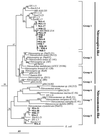Diversity and distribution of DNA sequences with affinity to ammonia-oxidizing bacteria of the beta subdivision of the class Proteobacteria in the Arctic Ocean
- PMID: 10788367
- PMCID: PMC101440
- DOI: 10.1128/AEM.66.5.1960-1969.2000
Diversity and distribution of DNA sequences with affinity to ammonia-oxidizing bacteria of the beta subdivision of the class Proteobacteria in the Arctic Ocean
Abstract
The spatial distribution and diversity of ammonia-oxidizing bacteria of the beta subdivision of the class Proteobacteria (hereinafter referred to as ammonia oxidizers) in the Arctic Ocean were determined. The presence of ammonia oxidizers was detected by PCR amplification of 16S rRNA genes using a primer set specific for this group of organisms (nitA and nitB, which amplifies a 1.1-kb fragment between positions 137 and 1234, corresponding to Escherichia coli 16S rDNA numbering). We analyzed 246 samples collected from the upper water column (5 to 235 m) during March and April 1995, September and October 1996, and September 1997. Ammonia oxidizers were detected in 25% of the samples from 5 m, 80% of the samples from 55 m, 88% of the samples from 133 m, and 50% of the samples from 235 m. Analysis of nitA-nitB PCR product by nested PCR-denaturing gradient gel electrophoresis (DGGE) showed that all positive samples contained the same major band (band A), indicating the presence of a dominant, ubiquitous ammonia oxidizer in the Arctic Ocean basin. Twenty-two percent of the samples contained additional major bands. These samples were restricted to the Chukchi Sea shelf break, the Chukchi cap, and the Canada basin; areas likely influenced by Pacific inflow. The nucleotide sequence of the 1.1-kb nitA-nitB PCR product from a sample that contained only band A grouped with sequences designated group 1 marine Nitrosospira-like sequences. PCR-DGGE analysis of 122 clones from four libraries revealed that 67 to 71% of the inserts contained sequences with the same mobility as band A. Nucleotide sequences (1.1 kb) of another distinct group of clones, found only in 1995 samples (25%), fell into the group 5 marine Nitrosomonas-like sequences. Our results suggest that the Arctic Ocean beta-proteobacterial ammonia oxidizers have low diversity and are dominated by marine Nitrosospira-like organisms. Diversity appears to be higher in Western Arctic Ocean regions influenced by inflow from the Pacific Ocean through the Bering and Chukchi seas.
Figures






References
-
- Aakra Å, Utåker J B, Nes I F. RFLP of rRNA genes and sequencing of the 16S-23S rDNA intergenic spacer region of ammonia-oxidizing bacteria: a phylogenetic approach. Int J Syst Bacteriol. 1999;47:661–669. - PubMed
-
- Alldredge A L, Silver M W. Characteristics, dynamics and significance of marine snow. Prog Oceanogr. 1988;20:41–82.
-
- Altschul S F, Gish W, Miller W, Myers E W, Lipman D J. Basic local alignment search tool. J Mol Biol. 1990;215:403–410. - PubMed
-
- Barry T, Powell R, Gannon R. A general method to generate DNA probes for microorganisms. Bio/Technology. 1990;8:233–236. - PubMed
-
- Conan P, Milton C. Variability of the northern current of Marseilles, western Mediterranean Sea from February to June 1992. Oceanolog Acta. 1995;18:193–205.
Publication types
MeSH terms
Substances
LinkOut - more resources
Full Text Sources
Molecular Biology Databases
Miscellaneous

